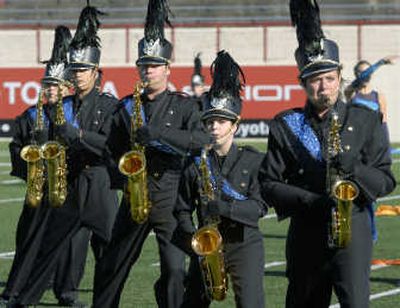Competition a high note for bands

Drum major Erin Headlee of Central Valley High School called her marching band to attention as it prepared to take the field at Joe Albi Stadium on Saturday.
“I’m really excited,” she said before the performance. “I can hardly hold it in.”
Her band was part of the Pacific Northwest Marching Band Championship, an event that has become a tradition for marching bands who bring their pageantry and fanfare from Idaho, Washington and, this year, Canada.
The competition has been sponsored the last four years by the Spokane Thunder Drum and Bugle Corps and the Greater Spokane Drum Corps Association. The groups took over from the Lilac Festival Association.
Harry Butler and Rich Harvey, presidents of the boards of each organization, said that each band was allowed to perform in the preliminaries and finals.
“It’s really not fair when you come 400 miles and get booted,” Butler said.
This year’s competition was significant because of who wasn’t there – Ferris, Lewis and Clark, Shadle Park, North Central and Rogers, the five Spokane public high schools. Dave Weatherred, coordinator of fine arts at Spokane Public Schools, said that the schools are going in different directions these days, but don’t always miss the marching band activity.
“They are teaching the skills and concepts of music,” he said.
Weatherred said the music department at Ferris focuses more on ensemble groups. Shadle has a marching band that competes but didn’t participate in this show, as does North Central.
“It’s a great activity,” he said. “Some years you’ll see our schools in it.”
Ron Crenshaw, band director at Rogers, doesn’t have a marching band because he thinks the students he was trying to recruit at the middle school level just weren’t interested. Since he made the decision not to field a marching band, he found that the music program has grown – from 15 wind players to 54.
There were 13 bands performing on Saturday. Judging criteria included marching and playing performance.
The students arrived at the stadium in school buses or chartered buses, along with rental trucks to haul their equipment.
And they have a lot of equipment. The pit – a percussion ensemble that plays at the 50-yard line – includes marimbas, vibraphones, cymbals, gongs, chimes and most anything you can hit with a stick.
That group complements the drum line, which includes snares, tenor drums and bass drums, who march in formation on the field.
The color guard – dancers who use flags, rifles, sabers and other items to add color and movement to the performance – can have about five pieces of equipment or more for each show.
And then there are the wind players. There are saxophones, Sousaphones, trumpets, clarinets, piccolos, flutes, trombones and baritone horns.
They all get on the field, perform and pack up in 15 minutes. Anything more would penalize the band’s score.
Marching band competition days can be long ones for the students. Many of them have traveled to town by bus, only to sleep huddled in a sleeping bag on the floor of a high school gymnasium when they arrive.
Then there are rehearsals and warm-ups and little details to take care of before the show.
Central Valley, which competed at the University of Oregon the previous weekend, gathered at school at 9 a.m. for practice, had a snack and hopped on the buses for Albi Stadium.
The band arrived around noon and split into different groups – the wind players did some stretching, the drum line began warming up their wrists with some warm-up exercises, and the color guard warmed up with some movement.
Everyone played some scales to warm up their instruments and practiced parts of the show that needed tweaking.
Closely following the band at all times are the parents.
Patty Weiser, Angie Wingett and Rita McNeilly were all there, not just to cheer on their children, but to help out.
The group shined shoes, passed out bottles of water, and attached plumes into the band’s shakos, or hats.
“It takes at least 12 people at show,” Weiser said.
Eric Parker, band director at CV, said there are 105 participants in the school’s marching band this year.
He and his staff are proud of the show. It’s a patriotic theme based on the concept of “The Gifts of Freedom.”
Color guard captain Cassie Molloy, a senior, said her favorite part of the show is at the end.
“We do the Iwo Jima pose at the end, and the band does a company front,” she said. “It’s amazing.”
After the long break, the schools started the process all over again. There were warm-ups, stretching, practicing and performing.
When every school had performed a second time, they lined up on the field to receive their scores and trophies in a ceremony called a “retreat.”
“We do it for the mommies and daddies,” Harvey said.
Butler added, “It’s so fulfilling to see the success of the kids.”